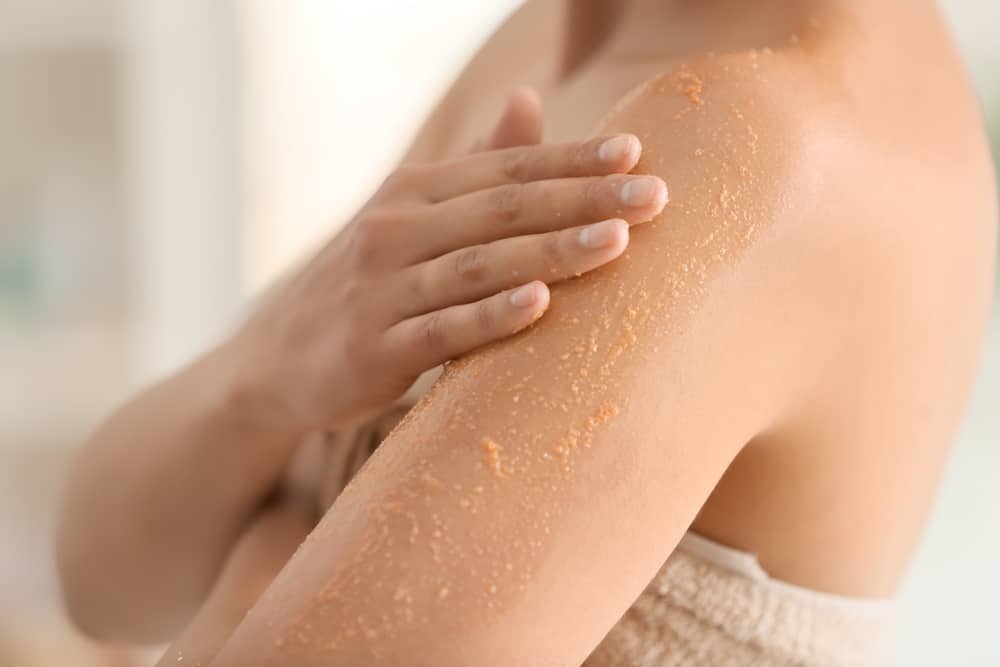Medically reviewed by Keria Tia Bean, APRN
Exfoliation can turn dry, dull skin into softer, smoother skin. But how to exfoliate your skin? And how often to exfoliate? There’s no one-size-fits-all answer. The best way to exfoliate your face or body and the best exfoliating products to use depend on your skin type and the condition of your skin.
Benefits of skin exfoliation
Normally, dead skin cells are shed every 30 days as part of the skin’s natural turnover cycle, but sometimes dead cells refuse to budge, making the skin dry, rough and dull. They can also clog your pores, contributing to acne or hard, tiny cysts called milia.
Exfoliation removes dead skin cells from the surface of your skin, which can make it feel smoother and look brighter and clearer. It also helps skincare products like moisturizer penetrate the skin more easily, making them more effective.
How to exfoliate: Chemical vs. manual exfoliation
There are two ways to exfoliate your skin at home: chemical exfoliation and mechanical (physical) exfoliation.
Chemical exfoliation products contain enzymes and/or acids, such as alpha-hydroxy acids (AHAs) and beta-hydroxy acids (BHAs), that loosen or dissolve dead skin cells so they slip off readily. They are sold in many forms, including exfoliating face washes, exfoliating body washes, peels, masks, serums and pads.
Mechanical exfoliation removes the dead cells through friction. Exfoliating body scrubs, exfoliating sponges, loofahs, exfoliating gloves, exfoliating brushes and washcloths act as mechanical exfoliants.
If you use an exfoliating scrub, apply only a small amount using small, light, circular motions. If you opt for an exfoliating tool such as a sponge or brush, use short, gentle strokes. Scrubbing too hard can irritate the skin, and you may create tiny tears that leave you vulnerable to infection.
Skin exfoliation guide by skin type
Your skin type will point you in the direction of either chemical exfoliation or mechanical exfoliation. It also dictates how often to exfoliate.
In general, people with oily skin may want to exfoliate more often than people with dry or sensitive skin. But here’s an important caveat no matter your skin type: Start slow. If you’re new to exfoliating, try exfoliating once a week and, if you need to exfoliate more often, work your way up to it. And recognize that your skin’s exfoliation needs may change with the seasons.
The best time to exfoliate is at night, after you’ve removed your makeup. Exfoliating in the morning will temporarily make your skin more sensitive to the sun’s rays.
For oily skin
How to exfoliate: Either mechanical exfoliation or chemical exfoliation with a product that contains salicylic acid will work for your skin. Salicylic acid is a type of BHA that’s particularly effective at removing excess oil and debris along with dead cells.
How often to exfoliate: Two to three times a week.
For acne-prone skin
How to exfoliate: Chemical exfoliation with beta-hydroxy acids is your best bet. Mechanical exfoliation can be too irritating for blemishes.
How often to exfoliate: Exfoliating two to three times a week may be appropriate, but it may be too much if you use retinols, retinoids or benzoyl peroxide. Ask your dermatologist for advice.
For normal skin
How to exfoliate: Both chemical and mechanical exfoliation are effective for normal skin, so the choice is yours.
How often to exfoliate: Two to three times a week.
For combination skin
How to exfoliate: Alternate between chemical and mechanical exfoliation (don’t use both on the same day).
How often to exfoliate: Twice a week.
For dry, sensitive skin
How to exfoliate: Chemical exfoliation is best for dry, sensitive skin. A product that contains lactic acid, one of the mildest forms of AHAs, is ideal for dry skin and skin that’s easily irritated. Bonus: Lactic acid attracts moisture to help keep your skin hydrated.
How often to exfoliate: Up to once or twice a week.
When not to exfoliate
Not everyone will benefit from exfoliation. You may end up with irritated, inflamed skin if you exfoliate too often or if you:
Use a product that makes your skin more sensitive and prone to peeling. These products include benzoyl peroxide, over-the-counter retinols and prescription retinoids. Exfoliating if you use one of them could worsen flakiness and lead to acne breakouts.
Have sunburned or damaged skin. Have a sunburn, rash or cuts? Don’t exfoliate until your skin heals.
Have a skin condition such as rosacea. If you have rosacea, exfoliating may worsen redness and irritation.
Professional skin exfoliation options
For deeper exfoliation customized to your skin type, see your skin care provider.
Exfoliating facials can remove dead skin skills and brighten dull skin. A more powerful, medical-grade treatment appropriate for all skin types is HydraFacial MD. This multi-step resurfacing procedure includes mechanical exfoliation, a chemical peel, extractions and an infusion of antioxidants and hyaluronic acid to plump, hydrate and protect skin. It’s perfect for smoothing and brightening as well as for reducing the appearance of fine lines, brown spots and acne scars.
Schedule an appointment today at one of our Florida offices.
Written by Jessica Brown, a health and science writer/editor based in Nanuet, New York. She has written for Prevention magazine, jnj.com, BCRF.org, and many other outlets.
